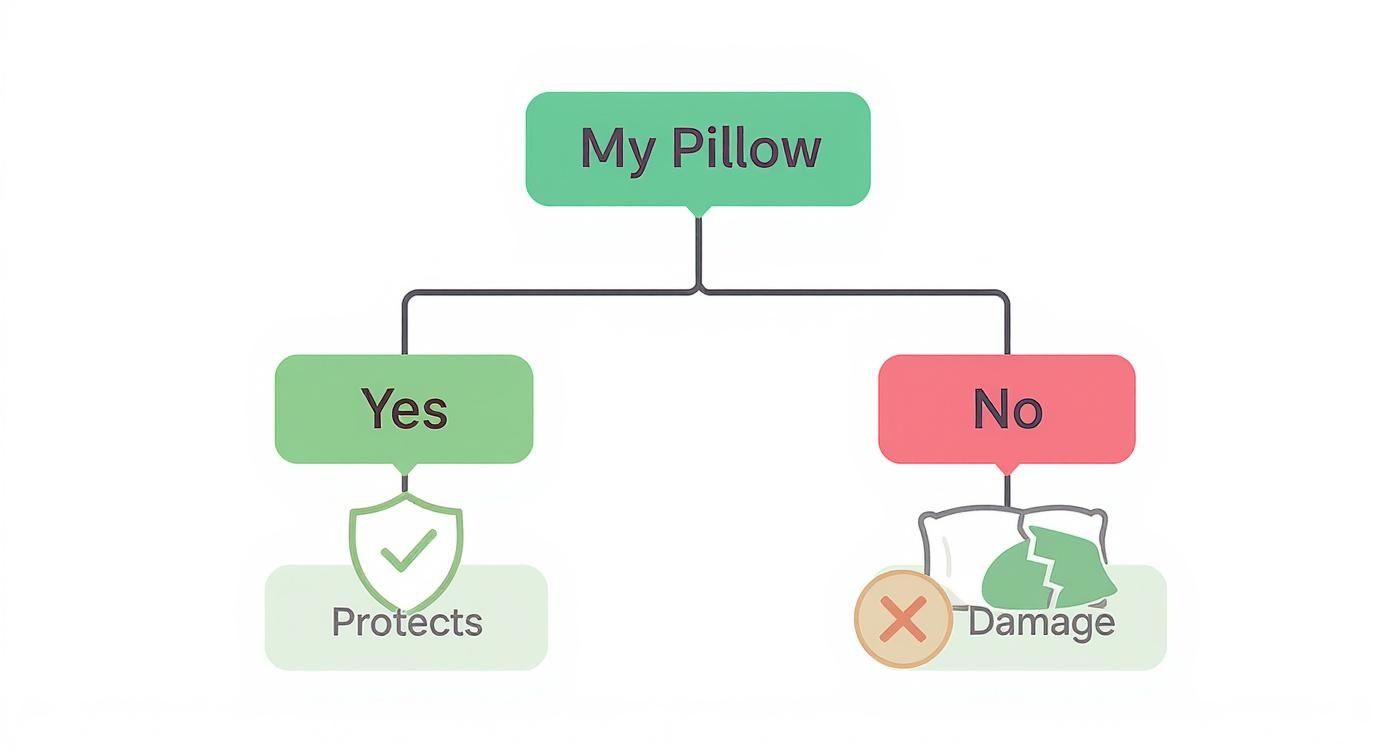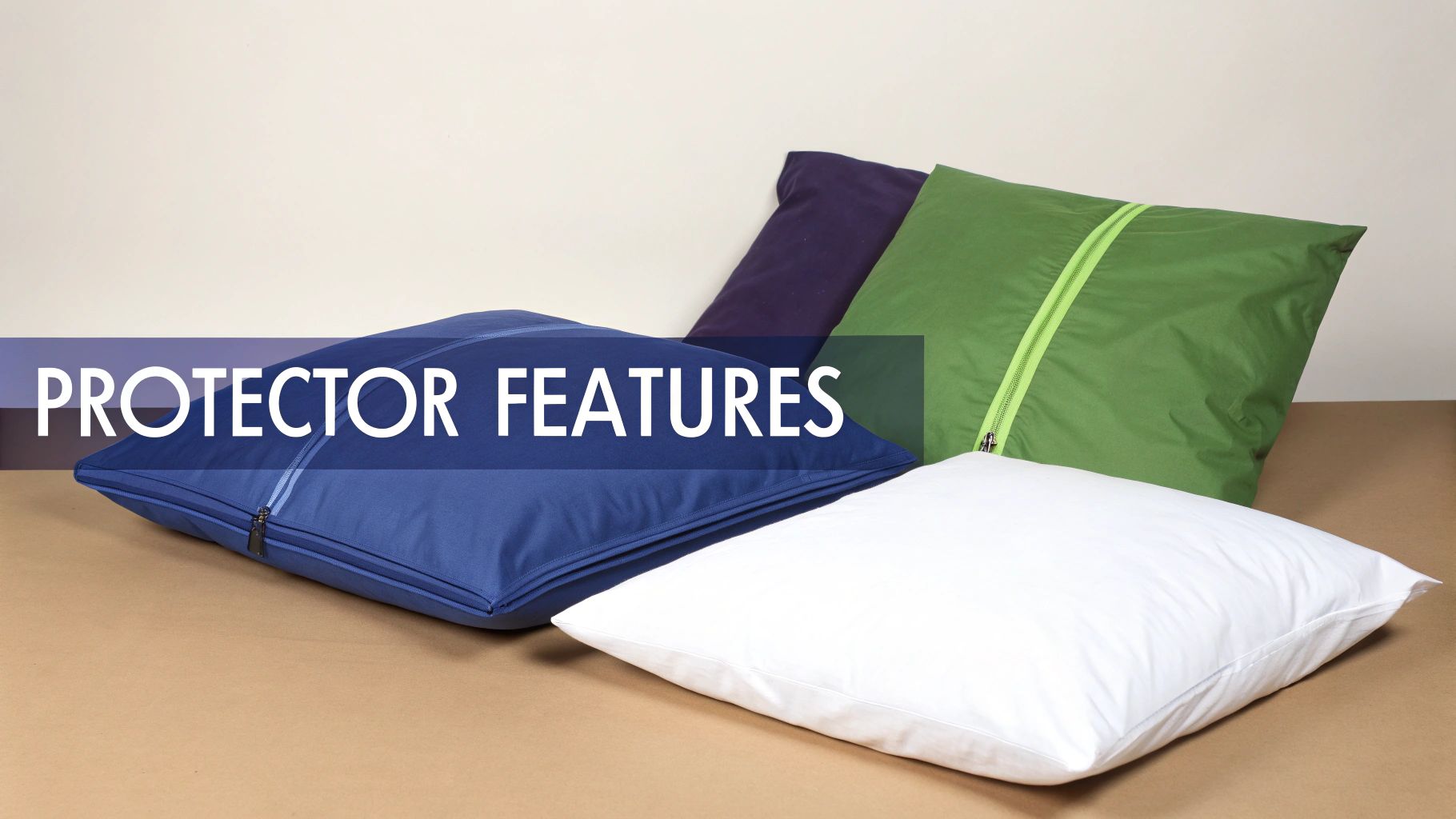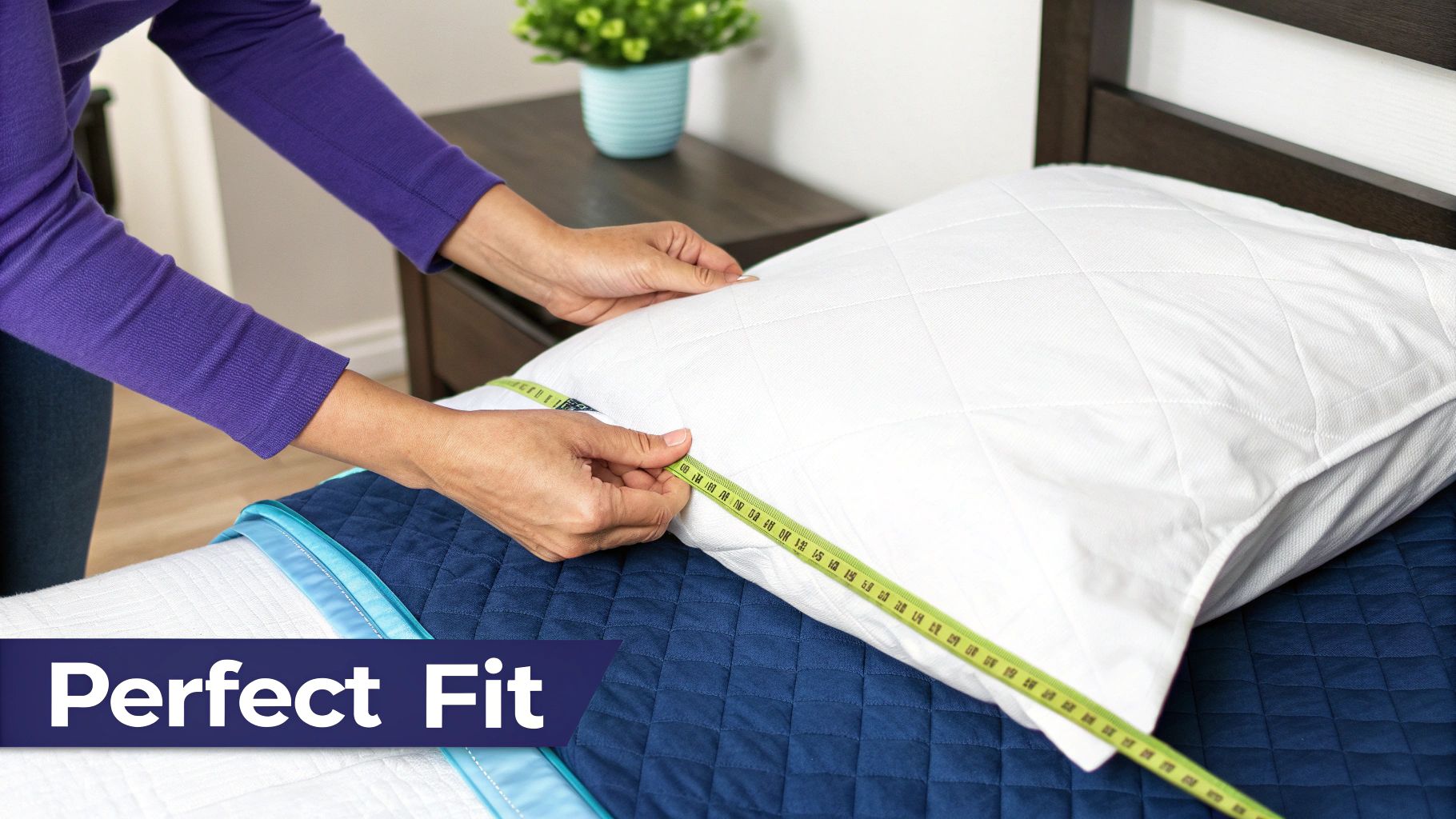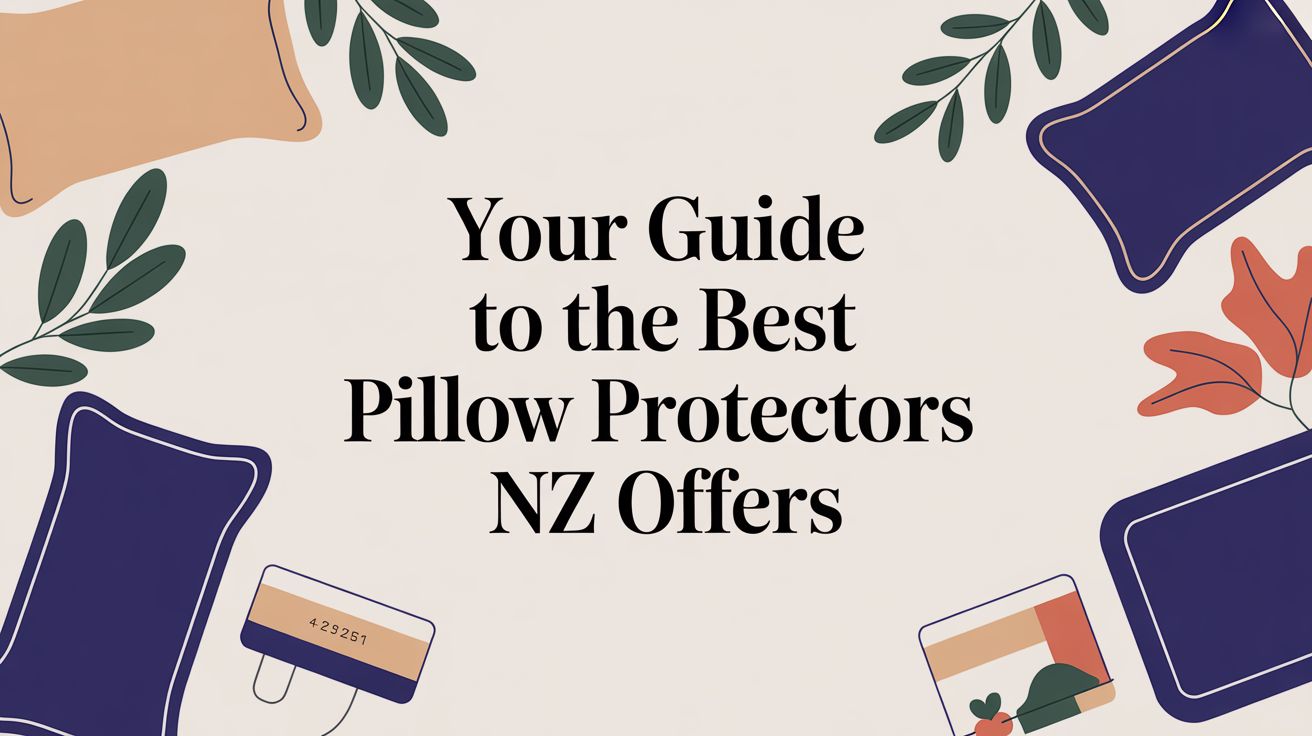A great pillow protector is a non-negotiable for a truly clean and comfortable bed, yet it's surprising how many Kiwis go without one. Think of it like a case for your phone—it's that simple, affordable layer that shields your pillow from everything life throws at it, keeping it fresh, hygienic, and supportive for years to come.
So, Why Bother With a Pillow Protector?
Let's get real about what happens when we sleep. Night after night, our pillows soak up a surprising mix of sweat, natural skin oils, makeup, and even hair products. Without a barrier, this buildup creates a damp, inviting environment for dust mites and bacteria, leading to unpleasant odours, yellow stains, and even potential skin irritation.
A pillow protector zips snugly around your pillow, fitting neatly under your regular pillowcase. It acts as a washable shield, stopping all that gunk from ever reaching the pillow itself. For any Kiwi home, this is a cornerstone of smart sleep hygiene.
Get More Life Out of Your Favourite Pillow
A quality pillow is an investment in your sleep and wellbeing. But without protection, that investment starts to degrade surprisingly fast. Moisture and oils break down the delicate filling—whether it's memory foam, feathers, or a synthetic blend—causing it to clump and lose its supportive loft.
A protector's job is to block these contaminants, keeping the inside of your pillow pristine and dry. This one small step can easily double the lifespan of your favourite pillow, saving you money and ensuring you get the consistent comfort you paid for.
A Cleaner, Healthier Place to Rest Your Head
If you deal with allergies or asthma, a pillow protector isn't just a good idea—it's essential. It creates a physical barrier that stops allergens like dust mites, pet dander, and pollen from getting deep into the pillow's fibres where they are impossible to wash out.
Here’s what that means for you every night:
- An Allergen Shield: It effectively blocks the tiny particles that can trigger sneezing, sniffles, and restless nights.
- Moisture Defence: It prevents sweat and accidental spills from soaking in, stopping mould and mildew from ever taking hold.
- Simple Hygiene: It’s far easier to strip off a protector and pop it in the wash than it is to try and deep clean an entire pillow.
This focus on creating a healthier sleep environment is a growing priority across New Zealand. In fact, the local bedding market, which includes essentials like pillow protectors in NZ, is projected to reach NZ$122.72 million in revenue by 2025. This shows just how many Kiwis are realising that small details can make a big difference to sleep quality. To see more on this trend, you can check out the market analysis from Business Research Insights.
Choosing the Right Protector Material
Picking the right material for your pillow protector is like choosing a jacket. You wouldn't wear a heavy-duty rain jacket on a sunny day in Hawke's Bay, and you wouldn't rely on a light windbreaker in a Fiordland downpour. The same logic applies to your bedding—the best fabric comes down to what you personally need for a great night's sleep.
The material you choose affects everything: how cool you feel, how quiet your pillow is, and how well it stands up to allergens and spills. It can be the difference between a comfortable, peaceful rest and a sweaty, crinkly mess.
Let's walk through the most common materials for pillow protectors in NZ so you can find the perfect match.
Cotton: The Breathable Classic
There's a reason cotton is a staple in bedding. It's soft, naturally breathable, and just feels good against your skin. Think of it as the favourite, comfy t-shirt of the bedding world—it's reliable, familiar, and easy to look after.
The biggest win for cotton is its fantastic air circulation. It allows heat and moisture to escape, preventing that stuffy, overheating feeling. For us Kiwis, that makes it a brilliant all-rounder, keeping you comfortable through humid summers and damp winters alike.
Cotton’s natural airflow is key to regulating your temperature as you sleep. It helps you avoid that clammy feeling that so often wakes people up, offering a perfect blend of comfort and simple, effective protection.
Bamboo: The Smooth, Cool Operator
Bamboo has really taken off in the bedding world, and once you feel it, you'll understand why. It's incredibly soft—often compared to silk—and it’s an absolute champion at wicking away moisture. If you tend to run hot at night, bamboo could be a game-changer.
This fabric works by pulling moisture away from your skin and letting it evaporate fast, leaving you feeling much cooler and drier. On top of that, it’s naturally hypoallergenic and antibacterial, which is a massive plus for anyone with sensitive skin or allergies.
Deciding to use a protector is a simple but vital step for both your health and your pillow's lifespan, as this quick decision tree shows.

As you can see, adding a protector is a clear win-win for keeping your pillow fresh and in good shape for years to come.
Polyester Blends: The Durable Defender
When it comes to sheer durability and protection, polyester and its blends are the heavyweights. They are tough, resistant to shrinking and stretching, and are often the go-to for top-tier waterproof protection.
Most of the best waterproof protectors today pair a soft polyester surface with a specialised polyurethane membrane on the back. This combination creates a powerful barrier that’s still breathable and, importantly, quiet.
If your main goal is to create a fortress against spills, sweat, and allergens, a quality polyester blend is a fantastic choice. It offers a level of security that's tough to match, making it ideal for kids' beds or anyone needing maximum defence. If you're after that same level of protection for your whole bed, our guide to finding a great waterproof mattress protector in NZ is a great place to start.
Pillow Protector Material Comparison
To make the choice a bit easier, here’s a quick side-by-side look at how these common materials stack up.
| Material | Best For | Breathability | Care Instructions |
|---|---|---|---|
| Cotton | Everyday comfort, mild allergies, and those who prefer natural fibres. A great all-rounder for the NZ climate. | High - Excellent airflow keeps you cool and dry. | Easy to care for. Machine washable on a warm or cold cycle. Can be tumble-dried on low. |
| Bamboo | Hot sleepers, sensitive skin, and allergy sufferers. Prized for its softness and cooling properties. | Very High - Superior moisture-wicking pulls sweat away from the skin. | Gentle machine wash in cold water. Best to line dry or tumble dry on the lowest heat setting. |
| Polyester Blends | Maximum protection against spills, stains, and dust mites. Ideal for kids or those with severe allergies. | Moderate - Modern blends are breathable, but the focus is on the waterproof barrier. | Very durable. Machine washable (often on a hot cycle for sanitation). Can be tumble-dried. |
Ultimately, there's no single "best" material—it's all about what feels right for you and provides the protection you need for a healthy, comfortable sleep.
Understanding Different Protector Features
Once you've settled on a fabric, it's time to look at the features that really make a pillow protector work for you. These aren't just minor bells and whistles; they’re smart design choices that solve real-life sleep problems, turning a simple cover into a specialised tool for a better night's rest.
It's a bit like buying a car. Any basic model will get you from A to B, but if you're navigating rough country roads or just want a quieter ride, you start looking for features like four-wheel drive or extra soundproofing. It's the same when you’re shopping for pillow protectors in NZ—the right features are designed to tackle specific challenges like allergies, spills, or overheating.

Total Encasement with Zippers
For the ultimate line of defence, nothing beats a zippered protector. Unlike the more common envelope-style covers that simply fold over at one end, a zippered protector completely encases the pillow, sealing it off from the outside world.
This design offers a 360-degree barrier, making it nearly impossible for dust mites, bed bugs, and other allergens to burrow into your pillow. If you or anyone in your family struggles with serious allergies or asthma, a zippered protector is an absolute must-have. It’s the key to creating a truly secure and hygienic sleep sanctuary.
Quiet and Breathable Waterproofing
The mere mention of a waterproof protector might bring back memories of those old-fashioned, crinkly plastic covers that were both noisy and uncomfortably hot. Thankfully, technology has come a very long way since then.
Today's best waterproof protectors use a micro-thin polyurethane membrane bonded to a soft, comfortable fabric. This clever combination is a bit of a marvel, offering several key benefits:
- Completely Silent: The membrane is so flexible that it moves with you, making absolutely no noise.
- Highly Breathable: It’s designed to let air and heat escape, which stops you from feeling hot and clammy.
- 100% Waterproof: It provides a foolproof barrier against all liquids, from sweat and drool to an accidental morning coffee spill.
This technology delivers serious protection without making you sacrifice an ounce of comfort. This same quiet, breathable approach is just as important for bigger bedding, and you can learn more about finding the right super king mattress protector that relies on similar advanced materials.
A high-quality waterproof membrane works like a smart gatekeeper. It’s fine enough to block large liquid molecules from getting in, but porous enough to let smaller air and vapour molecules out. This is the secret to keeping your pillow both dry and cool.
Specialised Fabrics for Better Sleep
Beyond just protecting your pillow, some protectors are designed with features that actively improve your sleep quality. For Kiwis who tend to sleep hot, cooling fabrics that use phase-change materials can be a game-changer. They absorb and release body heat throughout the night, helping you maintain a much more stable and comfortable temperature.
You'll also find hypoallergenic weaves, which have an incredibly tight construction. This makes the fabric naturally resistant to allergens without needing any chemical treatments, making it a fantastic choice for anyone with sensitive skin. By choosing a protector with features tailored to your needs, you're not just covering your pillow—you're upgrading it.
How to Find the Perfect Fit for Your Pillow
You've nailed down the right material and features for your new pillow protector—fantastic! But all that careful consideration goes out the window if the fit isn't right.
A protector that’s too loose will feel lumpy and bunch up inside your pillowcase. On the other hand, one that's too tight can compress the filling, completely changing the feel and support of your pillow. Getting the fit just right is a non-negotiable for both comfort and protection.
Think of it like a good pair of shoes. If they're too big, you’ll slip around, and if they're too small, they’ll pinch. Your pillow protector should be snug and secure, moving with your pillow without constricting it. The goal is for your pillow protector nz to do its job so well you forget it's even there.

Matching Your Pillow Size
Luckily, most pillows here in New Zealand stick to standard sizes, which makes finding a matching protector a breeze. The most common sizes you’ll find are:
- Standard (48cm x 73cm): The classic, go-to size that fits most beds.
- Queen (50cm x 80cm): A little longer than a standard, giving you a bit more surface area.
- King (50cm x 90cm): The longest of the lot, designed to sit perfectly across a king or super king bed.
Always double-check the dimensions on the packaging for both your pillow and the protector. Mismatched sizes are the number one reason for a poor fit. For a complete rundown on all bedding dimensions, our official NZ bed size guide has everything you need to know.
How to Measure for a Perfect Fit
What if you have a custom-made pillow or one with a unique shape? No worries—a quick measurement is all you need.
Just lay your pillow on a flat surface and grab a flexible measuring tape.
Measure from seam to seam, first checking the length and then the width. Be gentle and don't press down too hard, as that can skew the numbers. To make sure the protector will slide on without a struggle, add about 2-3 cm to each measurement.
This simple step takes less than a minute but it’s the best way to guarantee you buy the right size first time, avoiding the hassle of a return. It's the secret to getting a protector that feels like it was made just for your pillow.
Caring for Your Pillow Protectors
https://www.youtube.com/embed/ospqHz0bPdw
Buying a quality pillow protector is a great first move, but it’s only half the job. To get the most out of it, you need to care for it properly. Regular, correct washing is what keeps that barrier against allergens, sweat, and spills doing its job day in and day out.
Think of it as the unsung hero of your bedding, working tirelessly to filter out all the stuff you don't want seeping into your pillow. If you don't clean the filter, it eventually stops working.
How Often Should You Wash Your Protector?
You’re likely already washing your pillowcases every week with your sheets—good on you! Your protector doesn't need to be cleaned quite that often.
As a solid rule of thumb, aim to wash your pillow protector nz at least once a month.
That said, there are a few situations where you might want to wash it more frequently:
- If you suffer from allergies or asthma: Pop it in the wash every two weeks to keep dust mites and other triggers at bay.
- If you're a hot sleeper: More sweat means you'll want to wash it more often to stop bacteria from building up.
- If you've been sick: Once you're feeling better, it's a good idea to wash all your bedding—protector included—to banish any lingering germs.
Washing and Drying: The Right Way
First things first: always check the care label on your protector. Different materials need different handling. For most standard cotton or polyester protectors, a warm wash cycle (around 40°C) is the sweet spot. It’s hot enough to kill off germs and dust mites but gentle enough to not damage the fabric.
A quick tip: skip the fabric softener. It can leave behind a film that actually makes the protector less breathable.
When it's time to dry, letting it air-dry is your best bet, especially if it has a waterproof layer.
There's nothing better than hanging your protector on the line to let the New Zealand sun do its work. It's a fantastic natural sanitiser. If you're using a dryer, always use a low-heat setting. High heat is the enemy of waterproof membranes—it can cause them to shrink, crack, or even melt, which completely ruins their ability to protect your pillow.
This gentle-but-thorough approach is a great principle for all your bedding. If you’re planning a full bedding refresh, our guide on cleaning a mattress has some fantastic, practical advice.
Knowing When It's Time for a Replacement
Even the best pillow protector won’t last forever. All those nights and wash cycles eventually take their toll. You’ll know it’s time for a new one when you see tell-tale signs like stains that just won't come out, fabric that looks thin or worn, or a broken zip.
A good guideline is to plan on replacing your protectors every one to two years.
Keeping your bedding fresh is a continuous process. For a deeper dive, understanding when to refresh and replace your bedding provides great insights that will help you maintain a truly hygienic and comfortable bed.
Pillow Protectors in Hotels and Healthcare
Ever checked into a Kiwi hotel and wondered how they keep the bedding so incredibly clean and fresh? A big part of that five-star feeling comes down to one simple, hardworking item: a quality pillow protector. In places like hotels and hospitals, these aren't just an optional extra; they're an essential part of the operation.
For hotels and motels all over New Zealand, protectors are a non-negotiable. They protect a significant investment in good pillows by creating a tough, washable barrier against the sweat, oils, and accidental spills that come with a high turnover of guests. It’s how they guarantee every new arrival gets that pristine, hygienic bed experience.
The Standard in Health and Hygiene
The role of pillow protectors in NZ is even more vital in healthcare. Think about hospitals, clinics, and aged care facilities – they rely on medical-grade protectors to meet strict infection control standards. These protectors are a step up, often fully waterproof, antimicrobial, and built to handle the intense, high-temperature washing required to kill off pathogens.
The demand from these sectors is huge. In New Zealand, with hundreds of aged care facilities and public hospitals, there's a constant need for medical-grade protectors that are both waterproof and antimicrobial. This isn't just a local thing; it reflects a global trend in the bedding market.
In these professional settings, a protector isn't just about cleanliness—it's about health and safety. It’s a frontline defence that helps prevent the spread of bacteria and ensures a safe environment for both patients and guests.
This level of protection isn't just for large institutions. Pillow protectors are also crucial for maintaining hygiene in home health care settings, where people might be receiving advanced medical care at home.
Whether it’s a luxury hotel or a hospital ward, the principle is exactly the same: a protector is the ultimate foundation for a clean, safe, and comfortable rest.
Common Questions About Pillow Protectors
It’s one thing to understand the benefits, but another to know how a pillow protector fits into your daily life. It’s completely normal to have a few practical questions pop up.
Let's clear up some of the most common things we get asked by Kiwis about looking after their new protectors.
How Often Should I Wash My Protector?
For the best results, aim to wash your pillow protector at least once a month. This keeps it fresh and working at its best, stopping any grime from building up over time.
You might want to wash it a bit more often, say, every couple of weeks, if any of these apply to you:
- You suffer from bad allergies or asthma and need to keep dust mites at bay.
- You're a hot sleeper or tend to sweat a lot at night.
- You've just gotten over being sick – it’s a good idea to wash away any lingering germs.
Do I Still Need a Pillowcase?
Yes, you definitely do. A pillow protector and a pillowcase play two very different, but equally important, roles.
Think of the protector as the hardworking underlayer for your pillow, creating a barrier against moisture, sweat, and allergens. Your pillowcase, on the other hand, is the soft, comfortable layer your head actually rests on.
You'll still want to wash your pillowcase every week with the rest of your sheets. The protector underneath doesn't need washing nearly as often.
This two-layer system is the real secret to keeping your pillow in top condition. The pillowcase handles the surface-level stuff and is easy to whip off and wash, while the protector provides that deeper defence against the things that can really ruin a good pillow.
This simple routine makes your entire bed a cleaner, healthier place to be. If you've got more questions about looking after your bedding, we’ve put together a heap of information on our frequently asked questions. Our detailed FAQs page has got you covered.
Ready to give your pillows the protection they deserve? At New Zealand Bed Company, we have a fantastic range of high-quality pillow protectors perfect for any Kiwi home. Shop our collection online today and invest in a cleaner, healthier sleep.

